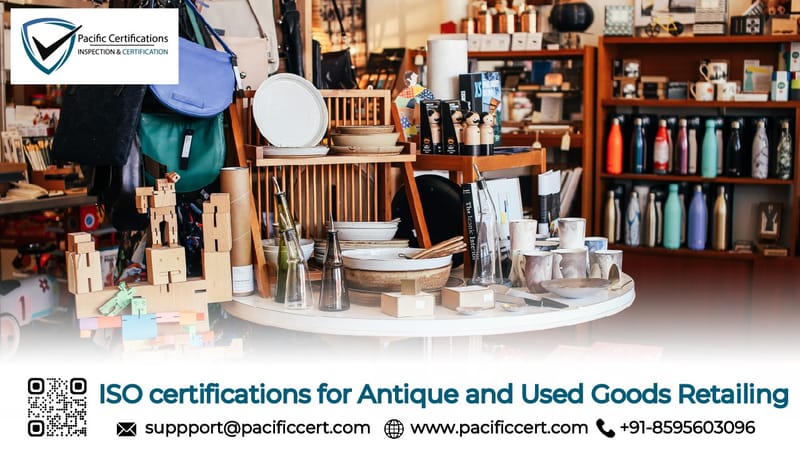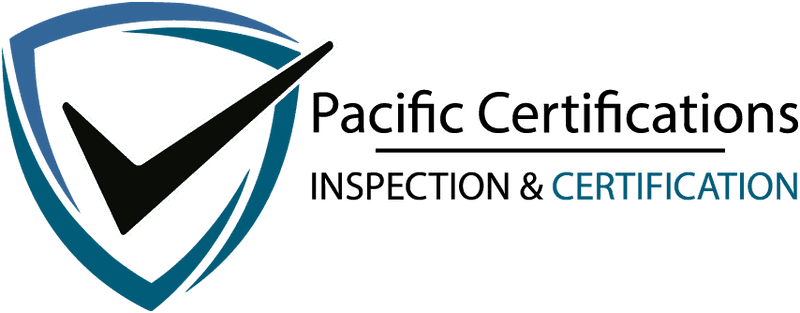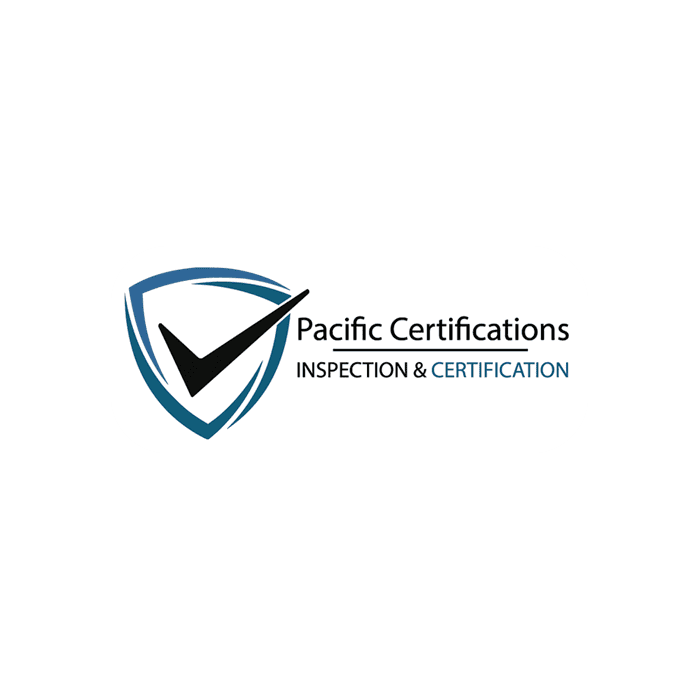ISO Certifications for Antique and Used Goods Retailing Businesses, Requirements and Benefits

Antique and used goods retailing is a unique sector that combines the charm of history with the sustainability of reuse. This industry has grown significantly over the years, fueled by an increasing interest in vintage items, eco-conscious consumer behavior, and the desire for unique and high-quality products with historical value.
However, like any other retail sector, antique and used goods businesses must adopt certain standards to ensure the quality, authenticity, and safety of the items they sell. This is where ISO certifications come into play.
ISO certifications provide a globally recognized framework for quality management, environmental responsibility, information security, and other critical areas that affect the operations of businesses, including those in the antique and used goods retailing sector.
By adopting ISO standards, antique and used goods retailers can enhance their credibility and trustworthiness and also streamline their operations and meet customer expectations more effectively.
Boost your credibility and customer trust by obtaining ISO certification for your Antique and Used Goods Retailing. Reach out to us at [email protected] or call +91-8595603096 today!
Applicable ISO Standards for Antique and Used Goods Retailing
The nature of the antique and used goods retailing industry means that a variety of ISO standards could be relevant, depending on the specific needs and focus of the business. Here are some of the key ISO standards that are applicable:
ISO 9001: Quality Management System
ISO 9001 is the most widely recognized quality management standard in the world. It provides a framework for businesses to ensure that their products and services consistently meet customer and regulatory requirements.
ISO 14001: Environmental Management System
ISO 14001 helps businesses manage their environmental impact through a structured approach. For antique and used goods retailers, adopting ISO 14001 can demonstrate a commitment to sustainability, such as through responsible sourcing, reducing waste, and promoting the reuse of goods.
ISO 45001: Occupational Health and Safety Management System
This standard provides a framework for managing workplace health and safety. Implementing this standard can help minimize workplace risks and ensure the safety of employees and customers.
ISO 27001: Information Security Management System
ISO 27001 provides guidelines for establishing, implementing, and maintaining an information security management system. For antique and used goods retailers, especially those with online stores, this certification can safeguard against data breaches and ensure the confidentiality and integrity of customer information.
ISO 20121: Sustainable Event Management
ISO 20121 helps organizations manage their events in a sustainable manner, ensuring that they minimize their environmental impact and contribute positively to society.
ISO 20400: Sustainable Procurement
ISO 20400 provides guidance on integrating sustainability into procurement processes. For antique and used goods retailers, this could mean ensuring that suppliers adhere to ethical practices and that the items sourced for resale are obtained through sustainable and responsible channels.
Click here to find out more applicable standards to your industry
Ensure compliance with globally recognized ISO standards for your Antique and Used Goods Retail business. Contact Pacific Certifications for expert audit and certification services at [email protected] or +91-8595603096.
How We Can Help
At Pacific Certifications, we understand the unique challenges faced by businesses in the antique and used goods retailing sector. As a certification body, we specialize in auditing and certifying businesses against various ISO standards. Our goal is to help you achieve certification efficiently and effectively, ensuring that your business meets all the necessary requirements and stands out in the marketplace.
Our Services Include:
- ISO Auditing: We conduct thorough audits to assess your compliance with the chosen ISO standard. Our auditors are experienced and knowledgeable in the antique and used goods retailing sector, ensuring that your business is evaluated by experts who understand your specific needs.
- Certification Issuance: Upon successful completion of the audit, we issue the ISO certification, giving you the credentials you need to demonstrate your commitment to quality and safety.
- Surveillance Audits: To maintain your certification, we provide ongoing surveillance audits to ensure continued compliance and help you address any areas of improvement.
It’s important to note that we do not provide consultancy, gap analysis, training, or implementation services. Our role is strictly to audit and certify, ensuring that there is no conflict of interest and that your certification is impartial and credible.
Looking to enhance the quality, safety, and sustainability of your Antique and Used Goods Retailing? Start your ISO certification journey with us by emailing [email protected] or calling +91-8595603096.
Requirements of ISO Certifications for Antique and Used Goods Retailing Business
The requirements for each of these ISO standards vary based on their specific focus areas. Below is an overview of the key requirements:
ISO 9001: Quality Management System
- Context of the Organization: Understanding the internal and external factors that affect the organization and identifying relevant interested parties (e.g., customers, suppliers).
- Leadership: Demonstrating top management’s commitment to the quality management system, establishing a quality policy, and assigning roles and responsibilities.
- Planning: Addressing risks and opportunities, setting quality objectives, and planning changes to the quality management system.
- Support: Ensuring adequate resources, competence, awareness, communication, and documentation management.
- Operation: Planning and controlling processes to meet quality requirements, including design, production, and service provision.
- Performance Evaluation: Monitoring, measurement, analysis, and evaluation of processes, including internal audits and management reviews.
- Improvement: Identifying and implementing actions to improve the quality management system, including corrective actions and continual improvement.
ISO 14001: Environmental Management System
- Environmental Policy: Developing an environmental policy that reflects the organization’s commitment to compliance, prevention of pollution, and continual improvement.
- Environmental Aspects: Identifying environmental aspects of the organization’s activities, products, and services that can impact the environment.
- Compliance Obligations: Identifying and ensuring compliance with legal and other requirements related to environmental aspects.
- Environmental Objectives: Setting measurable environmental objectives and planning actions to achieve them.
- Operational Control: Implementing procedures and controls to manage significant environmental aspects.
- Emergency Preparedness and Response: Planning for and responding to environmental emergencies.
- Monitoring and Measurement: Evaluating the environmental performance and effectiveness of the management system.
- Internal Audits and Management Review: Conducting regular audits and management reviews to ensure the system’s effectiveness and identify opportunities for improvement.
ISO 45001: Occupational Health and Safety Management System
- Leadership and Worker Participation: Top management must demonstrate leadership and commitment to the health and safety management system, with active participation from workers.
- Hazard Identification and Risk Assessment: Identifying workplace hazards and assessing risks, with a focus on eliminating or reducing them.
- Legal and Other Requirements: Identifying and complying with legal and other health and safety requirements.
- Objectives and Planning: Setting health and safety objectives and planning actions to achieve them.
- Support and Resources: Providing the necessary resources, training, and awareness to support the health and safety management system.
- Operational Controls: Implementing processes to manage risks, including emergency preparedness and response.
- Performance Evaluation: Monitoring and measuring health and safety performance, conducting internal audits, and management reviews.
- Improvement: Taking corrective actions to address incidents and non-conformities, with a focus on continual improvement of the management system.
ISO 27001: Information Security Management System
- Context of the Organization: Understanding the internal and external factors that affect information security, identifying relevant stakeholders, and defining the scope of the information security management system (ISMS).
- Information Security Policy: Establishing an information security policy that outlines the organization’s commitment to managing risks and protecting information.
- Risk Assessment and Treatment: Conducting a risk assessment to identify information security risks and implementing controls to mitigate them.
- Asset Management: Identifying and managing information assets to ensure they are adequately protected.
- Access Control: Implementing controls to ensure that only authorized individuals have access to information.
- Physical and Environmental Security: Ensuring the physical security of facilities and protecting information from environmental threats.
- Operations Security: Managing the security of operations, including protection against malware, backup management, and secure communication.
- Incident Management: Establishing processes for managing information security incidents and breaches.
- Compliance: Ensuring compliance with legal and regulatory requirements related to information security.
- Internal Audit and Management Review: Conducting regular audits and management reviews to ensure the ISMS is effective and continually improved.
These requirements form the foundation for each of the respective ISO standards and are crucial for organizations aiming to achieve certification and improve their overall operations in areas of quality, environment, health and safety etc.
Stand out in the market with ISO certification for your Antique and Used Goods Retail business. Contact us at [email protected] or +91-8595603096 to begin the process.
Benefits of ISO certifications for Antique and Used Goods Retailing
The benefits of ISO standards are wide-ranging and provide significant value to organizations across various industries. Below are the key benefits:
- ISO 9001 helps organizations implement a quality management system that enhances the consistency of products and services.
- By standardizing processes and eliminating waste, ISO 9001 enables organizations to improve operational efficiency and productivity.
- ISO 9001 focuses on meeting customer requirements and improving customer satisfaction.
- ISO 9001 certification is recognized globally and can enhance an organization’s reputation..
- ISO 14001 helps organizations identify and manage their environmental aspects, leading to a significant reduction in environmental impact, such as reduced waste and emissions.
- ISO 14001 ensures that organizations comply with environmental laws and regulations, reducing the risk of fines and legal issues.
- ISO 45001 provides a framework for identifying and managing workplace hazards, leading to a reduction in accidents, injuries, and illnesses.
- ISO 27001 helps organizations implement controls to protect sensitive information from breaches, ensuring data confidentiality, integrity, and availability.
- ISO 20121 helps organizations plan and manage events in a way that reduces their environmental footprint.
- ISO 20400 helps organizations implement sustainable procurement practices, ensuring that suppliers adhere to ethical standards and responsible practices.
Each of these ISO standards offers distinct benefits that can significantly enhance the operations and success of an organization.
Achieve ISO certification for your Antique and Used Goods Retailing to improve operations and attract more customers. Email [email protected] or call +91-8595603096 to get started.
Market News
This year, the antique and used goods retailing market is experiencing several noteworthy trends. The global market for vintage and second-hand goods continues to grow, driven by increasing consumer demand for sustainable and unique products. According to recent research, the second-hand market is expected to reach $77 billion by 2025, with significant growth in online platforms and marketplaces dedicated to vintage and used goods.
Sustainability is a major factor in this growth, as consumers become more aware of the environmental impact of their purchasing decisions. This trend aligns with the goals of ISO 14001, making environmental management a critical focus for businesses in this sector.
Additionally, the rise of digitalization in retail is leading to increased concerns about data security, particularly in online transactions. ISO 27001 is becoming increasingly relevant for antique and used goods retailers who operate e-commerce platforms, as it provides a framework for protecting customer data and ensuring secure online operations.
Ready to enhance your Antique and Used Goods Retail business with ISO certification? Contact us at [email protected] or +91-8595603096 for expert guidance and support.
Certification Process
The process of obtaining ISO certification for your antique and used goods retailing business involves several key steps:
1. Gap Analysis (Optional)
Before starting the certification process, some businesses opt to conduct a gap analysis to identify areas where they may not fully meet the requirements of the chosen ISO standard.
2. Develop and Implement the Management System
Once you have chosen the relevant ISO standard(s), the next step is to develop and implement the necessary management system.
3. Internal Audit
Conduct an internal audit to assess your compliance with the ISO standard. This audit will help you identify any areas that need improvement before the external audit.
4. External Audit
We will conduct an external audit to evaluate your compliance with the ISO standard. This audit is performed by our certified auditors, who will review your documentation, processes, and practices to ensure they meet the standard’s requirements.
5. Certification Decision
After the audit, we will review the findings and make a certification decision. If your business meets the requirements of the standard, we will issue the ISO certification. If there are any non-conformities, you will need to address them before certification can be granted.
6. Surveillance Audits
To maintain your ISO certification, we will conduct regular surveillance audits to ensure continued compliance. These audits help identify areas for improvement and ensure that your business remains aligned with the ISO standard.
Ready to take your antique and used goods retailing business to the next level? Achieving ISO certification can help you stand out in the market!
Pacific Certifications is accredited by ABIS, in case you need support with ISO certification for your Antique and Used Goods Retailing business, please contact us at [email protected] or +91-8595603096.
Our team is here to assist you with all your ISO certification needs.
FAQs: ISO Certifications for Antique and Used Goods Retailing
What is ISO certification, and why is it important for antique and used goods retailers?
ISO certification is a globally recognized standard that demonstrates a business’s commitment to quality, safety, environmental responsibility, and other key areas. For antique and used goods retailers, ISO certification can enhance credibility, improve operational efficiency, and build customer trust.
How long does it take to obtain ISO certification?
The timeline for obtaining ISO certification varies depending on the size and complexity of your business, as well as the specific ISO standard. On average, the process can take several months, from initial planning to final certification.
Do I need to get certified in multiple ISO standards?
While it’s not mandatory to get certified in multiple ISO standards, many businesses choose to do so to address different aspects of their operations. For example, you might choose ISO 9001 for quality management, ISO 14001 for environmental management, and ISO 27001 for information security.
What happens if my business doesn’t pass the external audit?
If your business does not pass the external audit, you will be given a list of non-conformities that need to be addressed. Once you have made the necessary corrections, a follow-up audit can be scheduled to reassess your compliance.
How much does ISO certification cost?
The cost of ISO certification varies depending on factors such as the size of your business, the number of locations, and the specific ISO standard. We can provide you with a customized quote based on your unique needs.
Read More at: Blogs by Pacific Certifications

